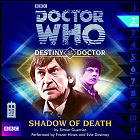 As the Doctor shows off his latest innovation to Jamie and Zoe – a rudimentary gauge added to the console to show the year in which the time machine has landed – just as the TARDIS is dragged off course violently. It makes an emergency landing on a planetoid in orbit around a pulsar whose gravitational effects on local spacetime pulled the TARDIS here. An ancient city lies nearby, with a human expedition puzzling over what is found there – and something is slowly stalking that expedition. The Doctor recognizes it as an entity capable of manipulating time, and braces himself to sacrifice years of his own life to save his friends.
As the Doctor shows off his latest innovation to Jamie and Zoe – a rudimentary gauge added to the console to show the year in which the time machine has landed – just as the TARDIS is dragged off course violently. It makes an emergency landing on a planetoid in orbit around a pulsar whose gravitational effects on local spacetime pulled the TARDIS here. An ancient city lies nearby, with a human expedition puzzling over what is found there – and something is slowly stalking that expedition. The Doctor recognizes it as an entity capable of manipulating time, and braces himself to sacrifice years of his own life to save his friends.
written by Simon Guerrier
directed by John Ainsworth
music by Simon HuntCast: Frazer Hines (Jamie / The Doctor), Evie Dawnay (Sophie)
Notes: The second Doctor receives a note from the eleventh Doctor via psychic paper; apparently the Doctor hasn’t encountered psychic paper before now. The Doctor is pleased with his future self’s taste in bow ties. Jamie boarded the TARDIS at the age of 22 (The Highlanders), but has lost track of how much time he’s spent aboard the TARDIS other than “two or three years.”
Timeline: after The Invasion and before The Krotons
LogBook entry and TheatEar review by Earl Green
Review: I’m not sure I can heap enough praise upon Frazer Hines without sounding like a broken record. Here, he pulls off the neat hat trick of recreation the second Doctor, Jamie and Zoe, while also maintaining a distinct neutral narrator voice into the bargain. Evie Dawnay adds some variety. but let’s face it, Frazer Hines probably could’ve done that one other character’s voice as well.
The story itself feels slightly strange. With stories set in the early years of Doctor Who, you have two choices: hew closely to what knowledge was available to the writers of the 1960s and 1970s, or put the “vintage” Doctor in a thoroughly modern adventure. Shadow Of Death falls into the latter category, with up-to-date astronomical phenomena such as pulsars and spacetime featuring heavily in the plot, but with its “base under siege” plot outline, it feels both modern and utterly Troughton-era traditional at the same time.
